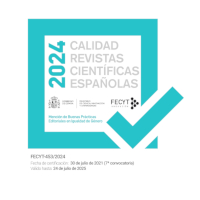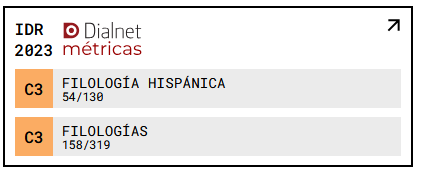Jajaja, jejeje, jijiji: funciones pragmáticas asociadas con las transcripciones de risa en la comunicación mediada por computadora en español
DOI:
https://doi.org/10.18172/cif.4405Palabras clave:
Pragmática, comunicación mediada por computadora, risa, interjecciones, vocalesResumen
Este artículo describe un estudio de las funciones pragmáticas asociadas con las transcripciones onomatopéyicas de risas en la comunicación mediada por computadora (CMC) en español, realizado por medio de un cuestionario aplicado a estudiantes universitarios costarricenses. En escalas Likert de cinco puntos, los participantes evaluaron el grado en el que seis tipos de risa transcrita —jaja, jajaja, jeje, jejeje, jiji y jijiji— podrían desempeñar diez funciones pragmáticas propuestas. Se obtuvo una serie de resultados estadísticamente significativos que asocian tanto la calidad vocálica como la cantidad de sílabas con distintas funciones. Los hallazgos servirán de base para futuros análisis de estos elementos en corpus reales de CMC.
Descargas
Citas
ANDROUTSOPOULOS, J. (2007). “Neue Medien – neue Schriftlichkeit?”. Mitteilungen des Deutschen Germanistenverbandes 1/07: 72-97.
BALNAT, V. (2011). Kurzwortbi ldung im Gegenwartsdeutschen. Germanistische Linguistik Monographien, Vol. 26. Zúrich; Nueva York: Olms, Hildesheim.
BARON, N. S. (1984). “Computer Mediated Communication as a Force in Language Change”. Visible Language 18 (2): 118-141.
BARON, N. S. (2000). Alphabet to email: How written English evolved and where it’s heading. Londres: Routeledge.
BARON, N. S. (2004). “See you online: gender issues in college student use of instant messaging”. Journal of Language and Social Psychology 23 (4): 397-423. https://doi.org/10.1177/0261927X04269585 DOI: https://doi.org/10.1177/0261927X04269585
CAPITAL.PE. (2015). “Sabes qué significa un ‘jajaja’ o un simple ‘ja’ en las redes sociales”. <https://capital.pe/actualidad/sabes-que-significa-un-jajaja-o-un-simple-ja-en-las-redes-sociales-noticia-777175>. (Acceso 25 de octubre de 2019).
CASSANY, D. (2003). “La escritura electrónica”. Cultura y Educación 15 (3): 239-251.
CRYSTAL, D. (2006). Language and the Internet (2ª ed.). Cambridge: Cambridge University Press. DOI: https://doi.org/10.1017/CBO9780511487002
CRYSTAL, D. (2011). Internet Linguistics: A Student Guide. Londres: Routeledge. DOI: https://doi.org/10.4324/9780203830901
DARICS, E. (2010). “Politeness in computer-mediated discourse of a virtual team”. Journal of Politeness Research 6 (1): 129-150. https://doi.org/10.1515/jplr.2010.007. DOI: https://doi.org/10.1515/jplr.2010.007
DRESNER, E. y HERRING, S. (2010). “Functions of the Nonverbal in CMC: Emoticons and Illocutionary Force”. Communication Theory 20: 249-268. DOI: https://doi.org/10.1111/j.1468-2885.2010.01362.x
FAGINAS, S. (2016). “¿Tú eres de jaja, de jeje o de jiji?”. La Voz de Galicia. <https://www.lavozdegalicia.es/noticia/yes/2016/05/28/tu-jaja-jeje-jijijejejejejejejijijijijijajajajajajaja/0003_201605SY28P32991.htm>. (Acceso 25 de octubre de 2019).
FOLQUÉS, L. y CARBAYO, N. (2016). “Lo que esconden los tipos de ‘jaja’ en las conversaciones de WhatsApp”. Código Nuevo. <https://www.codigonuevo.com/entretenimiento/esconden-lostipos-jaja-conversaciones-whatsapp>. (Acceso: 25 de octubre de 2019).
GLENN, P. y HOLT, E. (2013). “Introduction”, en Studies of Laughter in Interaction. (Coords. O. Glenn y E. Holt). Londres; Nueva York: Bloomsbury: 1-22. DOI: https://doi.org/10.5040/9781472542069.ch-001
GRICE, P. (1975). “Logic and conversation” en Syntax and semantics 3: Speech acts (Coords. P. Cole y J. Morgan). Nueva York: Academic Press: 41-58. DOI: https://doi.org/10.1163/9789004368811_003
GOLATO, A. y TALEGHANI-NIKAZM, C. (2006). “Negation of face in web chats”. Multilingua – Journal of Cross-Cultural and Interlanguage Communication 25 (3): 293-321. DOI: https://doi.org/10.1515/MULTI.2006.017
HÅRD AF SEGERSTAD, Y. (2002). Use and Adaptation of Written Language to the Conditions of Computer-Mediated Communication. Tesis doctoral, Universidad de Gotemburgo.
KAVANAGH, B. (2016). “Emoticons as a medium for channeling politeness within American and Japanese online blogging communities”. Language & Communication 48: 53-65. https://doi.org/10.1016/j.langcom.2016.03.003 DOI: https://doi.org/10.1016/j.langcom.2016.03.003
KOCH, P. y ÖSTERREICHER, W. (1985). “Sprache der Nähe – Sprache der Distanz. Mündlichkeit und Schriftlichkeit im Spannungsfeld von Sprachtheorie und Sprachgeschichte”. Romanistisches Jahrbuch 36: 15-43. DOI: https://doi.org/10.1515/9783110244922.15
KOCH, P. y ÖSTERREICHER, W. (1994). “Schriftlichkeit und Sprache”, en Schrift und Schriftlichkeit. Ein interdisziplinäres Handbuch internationaler Forschung. An Interdisciplinary Handbook of International Research (Vol. 1). (Coords. H. Günther y O. Ludwig). Berlín; Nueva York: de Gruyter: 587-604. DOI: https://doi.org/10.1515/9783110111293.1.5.587
KOCH, P. y ÖSTERREICHER, W. (2007). “Schriftlichkeit und kommunikative Distanz”. Zeitschrift für germanistische Linguistik 35: 346-375. DOI: https://doi.org/10.1515/zgl.2007.024
LI, L. y YANG, Y. (2018). “Pragmatic functions of emoji in internet-based communication – a corpus-based study”. Asian-Pacific Journal of Second and Foreign Language Education 3 (16). https://doi.org/10.1186/s40862-018-0057-z DOI: https://doi.org/10.1186/s40862-018-0057-z
MAÍZ-ARÉVALO, C. (2015). “Typographic alteration in formal computer-mediated communication”. Procedia – Social and Behavioral Sciences 212: 140-145. https://doi.org/10.1016/j.sbspro.2015.11.311 DOI: https://doi.org/10.1016/j.sbspro.2015.11.311
MAÍZ-ARÉVALO, C. y SANTAMARÍA-GARCÍA, C. (2013). “Hibridismo entre el lenguaje oral y el escrito: la comunicación a través del ordenador y las redes sociales”. Cuadernos Hispanoamericanos 761: 69-85.
MALLORY, J. P. y ADAMS, D. Q. (2006). The Oxford Introduction to Proto-Indo-European and the Proto-Indo-European World. Oxford: Oxford University Press.
MASON, B. L. (1998). “E-Texts: The Orality and Literacy Issue Revisited”. Oral Tradition 13 (2): 306-329.
MCKAY, I. (2015). Laughing with Letters: A Corpus Investigation of the Use of Written Laughter on Twitter. Tesis senior. University of Michigan.
MILLER, H. et al. (2017). “Understanding Emoji Ambiguity in Context: The Role of Text in Emoji-Related Miscommunication”. Eleventh International AAAI Conference on Web and Social Media, Montréal. DOI: https://doi.org/10.1609/icwsm.v11i1.14901
PETITJEAN, C. y MOREL, E. (2017). “‘Hahaha’: Laughter as a resource to manage Whatsapp conversations”. Journal of Pragmatics 110: 1-19. DOI: https://doi.org/10.1016/j.pragma.2017.01.001
REAL ACADEMIA ESPAÑOLA. (2014). Diccionario de la lengua española (23ª ed.). Madrid: Espasa.
ROCK, J. et al. (2013). Perspectives on Spoken Discourse. Milano: EduCatt.
SPINA, S. (2018). “Role of Emoticons as Structural Markers in Twitter Interactions”. Discourse Processes. https://doi.org/10.1080/0163853X.2018.1510654 DOI: https://doi.org/10.1080/0163853X.2018.1510654
TAGLIAMONTE, S. A. y DENIS, D. (2008). “Linguistic ruin? LOL! Instant messaging and teen language”. American Speech 83: 3-34. DOI: https://doi.org/10.1215/00031283-2008-001
VARNHAGEN, C. et al. (2010). “lol: new language and spelling in instant messaging”. Reading and Writing 23: 719-733. https://doi.org/10.1007/s11145-009-9181-y DOI: https://doi.org/10.1007/s11145-009-9181-y
WALTHER, J. B. y D’ADDARIO, K. P. (2001). “The impacts of emoticons on message interpretation in computer-mediated communication”. Social Science Computer Review 19: 324-347. https://doi.org/10.1177/089443930101900307 DOI: https://doi.org/10.1177/089443930101900307
Descargas
Publicado
Cómo citar
Número
Sección
Licencia
El autor o autora conserva todos los derechos sobre su artículo y cede a la revista el derecho de la primera publicación, no siendo necesaria la autorización de la revista para su difusión una vez publicado. Una vez publicada la versión del editor el autor está obligado a hacer referencia a ella en las versiones archivadas en los repositorios personales o institucionales.
El artículo se publicará con una licencia Creative Commons de Atribución, que permite a terceros utilizar lo publicado siempre que se mencione la autoría del trabajo y la primera publicación en esta revista.
Se recomienda a los autores/as el archivo de la versión de editor en repositorios institucionales.














